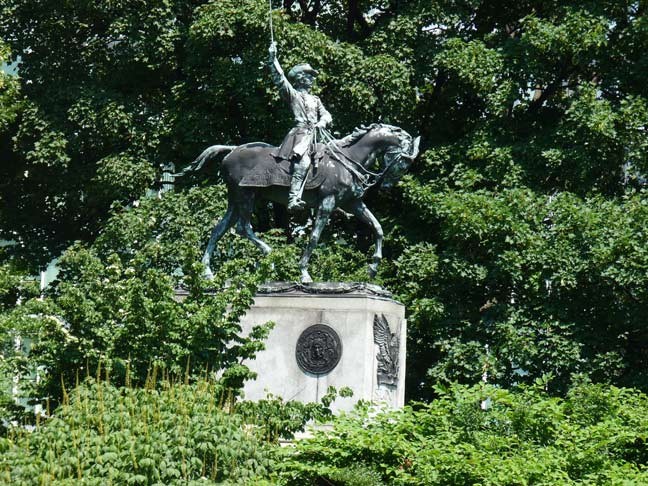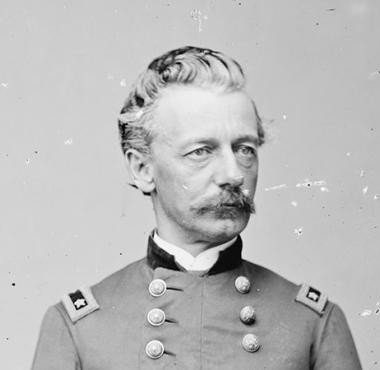General Henry Warner Slocum Monument
Introduction
Text-to-speech Audio
Images
General Henry Warner Slocum Monument

Henry Warner Slocum (1827-1894)

Backstory and Context
Text-to-speech Audio
Henry Warner Slocum was born in Delphi, Onondaga County, New York on September 24, 1827. The son of Matthew B. Slocum, a businessman, and Mary Ostrander, he enrolled in the United States Military Academy at West Point in 1848. Four years later, Slocum graduated near the top of his class and received a commission as a second lieutenant in the First Artillery. He served in Florida for roughly a year before being assigned to garrison duty at Fort Moultrie in Charleston Harbor in 1853. While in South Carolina, during his spare time, Slocum read law under B.C. Presley, who would later serve on the state’s supreme court. In 1854, he received a furlough to return to New York and marry Clara Rice. The couple would have four children. In March 1855, Slocum received a promotion to the rank of first lieutenant. He, however, eventually grew tired of garrison duty in South Carolina. On October 31, 1856, Slocum resigned his commission and returned home to Onondaga County, settling in Syracuse. There, in 1858, he was admitted to the bar and began a law practice. Not long after, Slocum entered into the political arena when he accepted an appointment as county treasurer. In 1859, he was elected to the state legislature.
When the Civil War broke out in 1861, Slocum volunteered to serve his country and was appointed colonel of the Twenty-Seventh New York Infantry, a volunteer regiment. During the First Battle of Bull Run, he suffered a serious wound to his left thigh. Soon after, Slocum received a promotion to the rank of brigadier general and took over command of a brigade serving in William B. Franklin’s division of the Army of the Potomac. During the initial stages of the Peninsula Campaign, he took over command of Franklin’s division. In July 1862, Slocum received a promotion to the rank of major general. In the wake of the Second Battle of Bull Run the following month, his division helped to cover the federal retreat. Despite being present at the Battle of Antietam in mid-September 1862, Slocum and his men did not see combat. Shortly thereafter, he was appointed to command the Twelfth Army Corps, which suffered heavy casualties at the Battle of Chancellorsville in May 1863. Two months later, Slocum and the Twelfth Corps composed part of the federal defensive line on Culp’s Hill. About a year later, he was appointed to command the Twentieth Corps. Slocum and his men participated in General William T. Sherman’s March to the Sea in late 1864 and his Carolinas Campaign in early 1865. In late September 1865, he resigned his commission and returned home to Syracuse.
In 1866, Slocum and his wife moved to Brooklyn. There, he opened a law practice and resumed his political career. Running as a Democrat, Slocum won three terms in the U.S. House of Representatives, serving from 1869 until 1873, and again from 1883 until 1885. On April 14, 1894, he died in Brooklyn. His remains were buried in Greenwood Cemetery.
Shortly after Slocum’s death, the City of Brooklyn decided to erect a monument in his honor. Created by renowned sculptor Frederick MacMonnies and esteemed architect Stanford White, the monument consists of a bronze life-sized equestrian statue on a granite pedestal. Slocum sits proudly on his horse, his left hand firmly clutching the reins and his right hand holding his sword above his head, as if leading troops into battle. The pedestal is embellished with a bronze eagle on the front and two bronze medallions on each side. On May 30, 1905, the monument was unveiled to the public at an elaborate, well-attended dedication ceremony. It originally stood on Eastern Parkway at Bedford Avenue. In 1922, deeming it a traffic hazard, the borough moved it to Fifteenth Street and Prospect Park West. Only six years later, the borough once again moved it, this time to its current location in Grand Army Plaza, the main entrance to Prospect Park.
Cite This Entry
Curran, Francis. "General Henry Warner Slocum Monument ." Clio: Your Guide to History. October 28, 2020. Accessed April 25, 2025. https://theclio.com/tour/421/13/reverse
Sources
Hartwig, D. Scott. "Slocum, Henry Warner." American National Biography. Oxford University Press. February 2000. Web. 28 October 2020 <https://www.anb.org/view/10.1093/anb/9780198606697.001.0001/anb-9780198606697-e-0500721;jsessionid=EF06DC565135C14AB31EF9FBF4908648>.
"Henry W. Slocum." American Battlefield Trust. Web. 28 October 2020 <https://www.battlefields.org/learn/biographies/henry-w-slocum>.
"Slocum, Henry Warner." Biographical Directory of the United States Congress, 1774-Present. United States Congress. Web. 28 October 2020 <https://bioguideretro.congress.gov/Home/MemberDetails?memIndex=S000496>.
Sprague, Elmer. Brooklyn Public Monuments: Sculpture for Civic Memory and Urban Pride. Indianapolis, IN: Dog Ear Publishing, 2008.
https://forgotten-ny.com/2013/08/downtown-to-prospect-park-part-2/
https://www.battlefields.org/learn/biographies/henry-w-slocum

